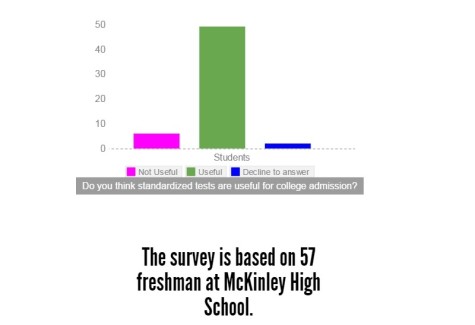New SAT set for 2016

March 8, 2015
McKinley’s class of 2017 will be the first to take the new SAT, in 2016, their junior year.
There will be changes in the three sections of the test: math, reading and writing. According to College Board President David Coleman, the new SAT will based on Common Core Standards.
The math sections will have link abstractions such as the graph of a line along with real-life situations. It will have a calculator and non-calculator portion. The reading section will have no vocabulary and the essay part has been redesigned.
There are some disadvantages in the new SAT. Students who have not adjusted to the Common Core Standards yet may not do well on it. Students who cannot afford to have one-to-one sessions with a tutor who could give tips on the new test as well as test-taking strategies may also not do well. The same applies to students who are from low-income families or have low English proficiency. At McKinley High School, there are 1071 students who receive free or reduced-cost lunch and 235 students with limited English proficiency out of the total 1757 students enrolled.
 Students in American public schools are expected to follow the Common Core Standards set by the DOE.
Students in American public schools are expected to follow the Common Core Standards set by the DOE.
English teacher Jude Waterman quoted from the Springboard book that when using a Common Core in the classroom, there is a disadvantage that “certain teaching units take longer than others.”
The Common Core Standards at McKinley High School states that it “allows students to achieve the learning expected by college and career readiness standards.”
The new SAT will give subscore reports for every test so that students, parents, etc. can see. There will also be no penalty for wrong answers.
Freshman Alyssa Bales said, “I worry about math and writing because for math, you can mess up on the steps and you never know if the answer is right or not. I mess up on grammar, and I don’t really follow the grammar rules. The essay part, I tend to repeat what I write and I run out of what I should say. It’s hard because you need a certain amount in a certain amount of time.”
Sample Problem: The recommended daily calcium intake for a 20-year-old is 1000 milligrams (mg). One cup of milk contains 299 mg of calcium and one cup of juice contains 261 mg of calcium. Which of the following inequalities represents the possible number of cups of milk (m) and cups of juice (j) a 20-year-old could drink in a day to meet or exceed the recommended daily calcium intake from these drinks alone?
- 299m+261j greater than or equal to 1000
- 299m+261j greater than 1000
- 299 over m +261 over j greater than or equal to 1000
- 299 over m +261 over j greater than 1000
The correct answer is A.



